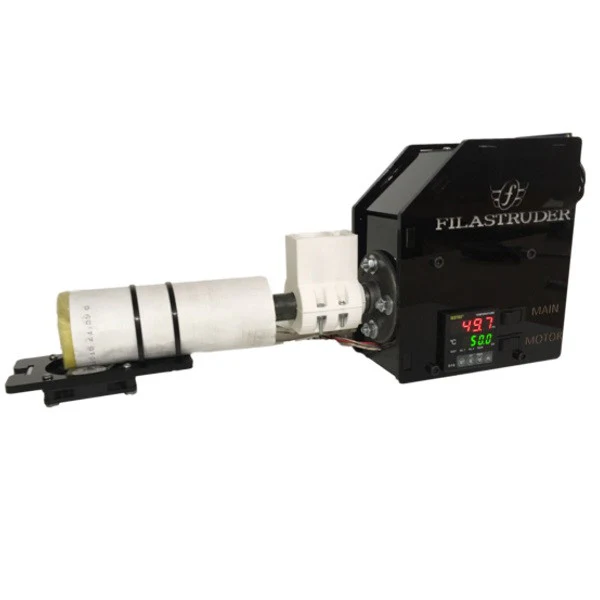The Filastruder: Revolutionizing Filament Recycling and 3D Printing
In the world of 3D printing, filament is the lifeblood of the craft. But as enthusiasts know, filament can be expensive, and waste can quickly pile up as prints fail or excess material is left over. This is where the Filastruder comes in—a machine designed to make filament production more sustainable, and cost-effective by allowing users to create their own filament from plastic pellets or recycled plastic. There are many similar filament extrusion devices in the market right now, but they are all significantly more expensive than the Filastruder, which is why the Filastruder is the best for a beginner to experiment with. But how does it work, and is it the right tool for your 3D printing needs?
What is the Filastruder?
The Filastruder is a DIY filament extruder that heats and melts plastic, extrudes it through a nozzle, and as it cools long strands of filament used in 3D printers are formed. The Filastruder allows users to control the diameter of the filament, making it customizable for different types of 3D printers. It can be a valuable tool for hobbyists looking to recycle plastic, reduce waste, and save on filament costs once you get it set up and dialed in.

Functionality
The Filastruder works by taking plastic pellets (typically ABS, PLA, or PETG) or shredded and clean plastic waste and feeding them into an extrusion barrel. The machine heats the plastic to its melting point in the barrel, then using an auger bit forces it through a nozzle that controls the filament’s diameter. As the filament is extruded, it passes through a cooling system (usually fans or a cold water bath) to solidify it into long, usable strands of filament.
The extruder comes with an adjustable nozzle to control the filament diameter, typically ranging from 1.75mm to 3mm. Users can adjust temperature settings based on the type of filament they are producing, as different plastics have different melting points. While the Filastruder is effective, it’s not an automatic process—you’ll need to monitor the temperature, feed rate, and filament quality during operation, getting the right consistent diameter is a bit tricky to get.
Pros and Cons
Pros:
- Cost-Effective: If you use a lot of filament for your 3D printing projects, the Filastruder can be a great way to save money. Plastic pellets are often cheaper than pre-made filaments, especially in bulk. And if you can use your plastic waste, that is even cheaper and reduces your carbon footprint at the same time.
- Sustainability: One of the biggest advantages of the Filastruder is its ability to recycle plastic. By using scrap filament, failed prints, or plastic waste, you can keep material out of landfills and oceans while creating usable filament for your printer.
- Customization: The Filastruder allows you to create filament in different diameters and materials, offering more flexibility than buying off-the-shelf filament. Although nowadays you can buy filament in almost every color you can imagine.
- Educational Tool: For those interested in the technical side of 3D printing, the Filastruder is a hands-on way to learn about the extrusion process, filament properties, and material science. The machine gives a lot of perspective into how the production of filament works.
Cons:
- Learning Curve: The process of making filament is not as straightforward as simply buying it from a retailer. Getting the correct filament diameter, consistent extrusion, and high-quality output takes some practice and fine-tuning.
- Time-Consuming: Producing filament with the Filastruder is a slower process compared to simply ordering pre-made filament. It can take several hours to extrude a decent amount of material.
- Quality Control: Although the Filastruder gives you control over the filament’s diameter, achieving the precise, high-quality filament that’s consistent enough for professional-grade prints can be challenging without experience.
If you are interested in my personal tips and tricks for using the Filastruder click here!
Is It Good for Recycling Plastic?
Yes, the Filastruder is excellent for recycling plastic, especially if you have access to waste materials like failed prints, old filament spools, or post-consumer plastic waste. By grinding up and reusing these materials, you can turn what would be waste into something valuable. However, recycling with the Filastruder requires careful sorting and preparation. For example, you can’t just throw in any plastic waste—you need to ensure it’s all the same type of plastic and clean to avoid contamination so that it mixes and extrudes well.
That being said, the quality of the recycled filament may not always be as consistent as new filament. Impurities or inconsistencies in the recycled plastic can affect print quality, so it’s important to do test prints to calibrate the process. When I was using the Filastruder I was using shredded household plastic waste mostly plastic number 2, HDPE. When I used the machine I struggled a lot with getting a consistent diameter, which made 3d printing very difficult.
Conclusion
The Filastruder is a powerful tool for those interested in 3D printing, recycling, and cost savings. It allows users to make their own filament and reduce waste, but it requires patience, practice, and attention to detail. While it might not be the easiest or quickest option, it can be incredibly rewarding for hobbyists, makers, and anyone passionate about sustainable 3D printing practices. If you can get a handle on the Filastruder I would recommend eventually upgrading to a similar but higher-quality filament extrusion device like the Filabot. If you are interested in learning about other viable recycled filament options click here!

